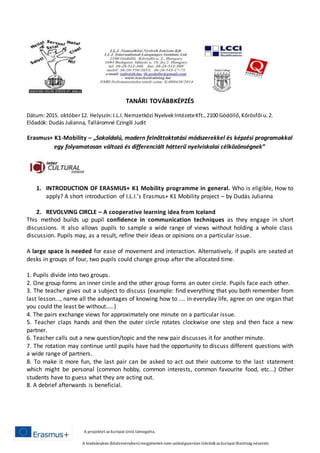
TT_12Oct2015_Workshop_handout_TCJ
- 1. A projektet azEurópai Unió támogatta. A kiadványban (közleményben)megjelentek nem szükségszerűen tükrözik azEurópai Bizottság nézeteit. TANÁRI TOVÁBBKÉPZÉS Dátum: 2015. október12. Helyszín:I.L.I.Nemzetközi NyelvekIntézeteKft.,2100 Gödöllő,Kőrösfői u.2. Előadók: Dudás Julianna, Talláromné Czingili Judit Erasmus+ K1-Mobility – „Sokoldalú, modern felnőttoktatási módszerekkel és képzési programokkal egy folyamatosan változó és differenciált hátterű nyelviskolai célközönségnek” 1. INTRODUCTION OF ERASMUS+ K1 Mobility programme in general. Who is eligible, How to apply? A short introduction of I.L.I.’s Erasmus+ K1 Mobility project – by Dudás Julianna 2. REVOLVING CIRCLE – A cooperative learning idea from Iceland This method builds up pupil confidence in communication techniques as they engage in short discussions. It also allows pupils to sample a wide range of views without holding a whole class discussion. Pupils may, as a result, refine their ideas or opinions on a particular issue. A large space is needed for ease of movement and interaction. Alternatively, if pupils are seated at desks in groups of four, two pupils could change group after the allocated time. 1. Pupils divide into two groups. 2. One group forms an inner circle and the other group forms an outer circle. Pupils face each other. 3. The teacher gives out a subject to discuss (example: find everything that you both remember from last lesson..., name all the advantages of knowing how to .... in everyday life, agree on one organ that you could the least be without.....) 4. The pairs exchange views for approximately one minute on a particular issue. 5. Teacher claps hands and then the outer circle rotates clockwise one step and then face a new partner. 6. Teacher calls out a new question/topic and the new pair discusses it for another minute. 7. The rotation may continue until pupils have had the opportunity to discuss different questions with a wide range of partners. 8. To make it more fun, the last pair can be asked to act out their outcome to the last statement which might be personal (common hobby, common interests, common favourite food, etc...) Other students have to guess what they are acting out. 8. A debrief afterwards is beneficial.
- 2. A projektet azEurópai Unió támogatta. A kiadványban (közleményben)megjelentek nem szükségszerűen tükrözik azEurópai Bizottság nézeteit. 3. REVOLVING CIRCLE – Memorising new vocabulary with the help of sentence expansion Aim: Teaching new vocabulary / Revising previously learnt vocabulary in new context 1. The arrangement of students is the same as above. 2. Each student gets a word card with the definition of the word/phrase and a sample sentence with the word/phrase on it. 3. The first student in each pair explains the meaning then reads the sample sentence. The other student memorises the sentence in bits and pieces by repeating and expanding the sentence. 4. After 1.5 mins T asks students to go on with the other student’s word card. They complete the same task and then exchange their cards. 5. Teacher claps hands and then the outer circle rotates clockwise one step and then face a new partner. 6. The new pair starts to memorise the new words/phrases for another 1.5-1.5 minutes. 7. The rotation may continue until students have learnt the vocabulary on each word card. 8. Follow-up: Any member of the class can be called up to repeat any sample sentence. Other students may help if the student does not manage. by Talláromné Czingili Judit